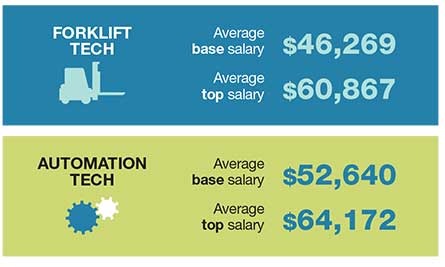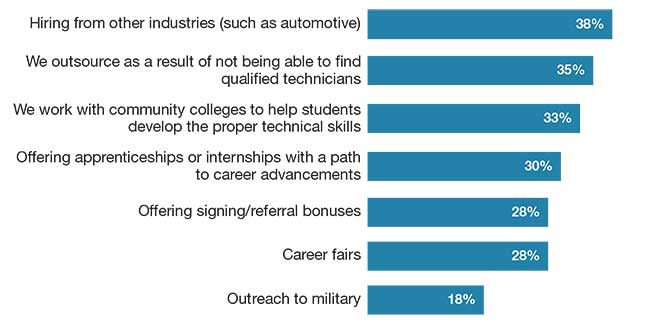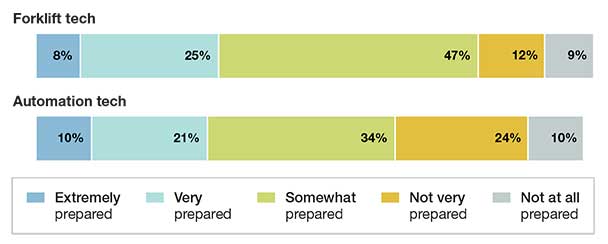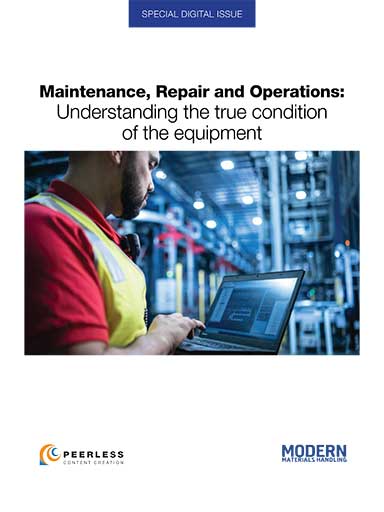Building (and maintaining) your maintenance, repair and operations (MRO) tech workforce
The story for finding and retaining techs continues to be challenging, but manageable.
Not long ago, pre-Covid to be exact, we lived in a world of big numbers. Whether it was GDP or employment or lots of other things, the big number was typically a really good indication of the situation.
And today, we still use big numbers to get a sense of what’s going on around us. Consider these reported in The Boston Globe at the start of February: “Many kinds of organizations have been desperate for workers for two years, and there’s no indication that the situation will change soon. The federal government counted 11 million job openings in December, an increase of 600,000 from the previous month, and the percentage of Americans looking for work is the lowest it’s been in 54 years.”
Man, but that’s a bleak assessment of the state of hiring across the broad economy. Almost feels like it’s time to give up and go home.
But, wait just a minute. How much does it ring true in the MRO world? Most specifically, does it apply to maintenance techs? In a word, NO. Yes, that was meant to be in capital letters.
In a recent Peerless Research Group survey, 20% of respondents with MRO hiring responsibility say “we have a very difficult time hiring and retaining technicians.”
That’s a long way from the hiring characterization in the Globe story. And while those big numbers are, in fact, from the federal government, they are not especially representative of what’s happening in our space, as it turns out. That’s an important distinction for you and other managers with MRO responsibilities.
That survey was done by the Peerless Research Group, a sister organization of Modern Materials Handling. The results offer a chance to recalibrate reality and expectations for MRO techs going forward.
The survey was conducted of our readership at the end of 2022. The more than 160 respondents were from companies of all sizes with the majority in manufacturing. While 51% have annual sales less than $100 million, 27% had sales exceeding $1 billion.
The survey gave all a chance to offer their assessment of the difficulty in hiring and retaining qualified techs as well as the critical skills they’re pursuing. Respondents also revealed what techs cost them.
The top line takeaway here is that maintenance techs are a challenging group these days. But, as you will see, those challenges are, for the most part, manageable. Not out of control. That said, making this work requires effort. There are no gimmes anymore.
With this survey, it’s clear that sometimes it’s best to have your nose pressed right up against the window to get a view of what’s really going on. Recalibration, indeed.
Base annual salary and top annual salary for forklift and automation techs

Caption: Source: Peerless Research Group (PRG)
The top line
As to the big question about hiring and retaining techs, people offered these additional views.
Forty-three percent said “it’s somewhat of an issue to find capable technicians.” Meanwhile, another 25% called it a minor issue. “It’s not an issue at all” was the response from 12%.
That’s not a bad distribution and hardly has a tone of doom and gloom. It’s also important to note that these numbers are similar to those reported last year (Modern, March 2022).
That’s when 22% called it difficult (20% this time) while 51% said somewhat of an issue (43% now) and 21% called it a minor issue (25% now). Interestingly, those characterizing hiring and retaining as not an issue increased nicely from 6% to 12%. Sounds like at least a small victory.
That’s when Peerless drilled down to pinpoint the key problems in all of this.
Nearly half, 49%, said finding the necessary skill sets is their top challenge. Hiring techs who are dedicated and responsible was another major problem, with 41% checking this box.
What actions are managers taking to nd/retain workers?

Caption: Source: Peerless Research Group (PRG)
So, what are they looking for? That’s a long list. In fact, the report from Peerless Research offers 10 pages of comments from respondents. Single-spaced. Many people were apparently eager to offer their own thoughts here. So, we’ll cherry pick some of the standouts.
- Ability to learn quickly
- Certifications
- Collaborative
- Desire
- Easy to communicate
- Electronic skills
- Experience
- Honesty
- Mechanical skills
- People skills
- Reliability
- Task oriented
- Troubleshooting skills
- Work ethic.
Clearly, a tech today is expected to be much more than good with tools. The individual’s mindset and ability to work with others are equally important.
That said, what’s it all worth to the techs? The chart on p. 121 gives the details.
Compared to last year, salaries are up across the board, except for base salary for lift truck techs, which fell $200. Top salary for those people rose almost 6%. Meanwhile, base salary for automation techs is up almost 3.5% while top salary climbed a little over 3%.
Risk management
Being successful at hiring and retaining techs is much more than a dollars and cents equation, however. In fact, there are challenges to being successful here both from within and outside the organization.
Fifteen percent of respondents said they lacked funding to hire techs. Which is a problem when 27% said competitors offer a higher wage and “steal our technicians.” That’s a little different, but not by much, from those 28% who said technicians “regularly move on to other opportunities.”
There’s still another issue here among the challenges from within.
Survey respondents were asked how they would describe their role in the MRO function overall. For the majority, 55%, MRO is one of their responsibilities. Another 27% have input. But only 19% say MRO is their main/primary responsibility.
That creates its own dynamic in the hiring and retaining process. If MRO is front and center everyday for not even 20% of managers, that must make it even more challenging to find and keep the right people. And this is as much a comment about the availability of good techs as where MRO fits in any company’s priorities.
To what degree are applicants for entry-level technician jobs prepared to repair and maintain equipment?

Caption: Source: Peerless Research Group (PRG)
That’s worth a comment here from someone who works in the arena every day. The issue of where MRO fits among other corporate priorities is a major concern, explained Jim Owens, chief growth officer at SDI, in the December issue of Modern.
He said, “companies have to shift their thinking to start. The days are gone when the emphasis in MRO is on cost per part and how the company can exert leverage to lower that price even further…Now, MRO is all about risk management from the production line or shipping dock to the bottom line. There is a direct link. MRO is about risk management on a scale most companies have never considered.”
Risk management puts hiring and retaining techs at an elevated level from how most are thinking these days. Hopefully, that’s a trend to track in future surveys.
Managing the pain
Pulling this back to the day-to-day, let’s focus on the applicant pool and what companies are doing to improve their chances of finding new people.
Managers are trying many different techniques to find and retain people. Some (38%) like to poach from other industries. Others (35%) outsource the task. Still others (33%) work with local community colleges to build their workforce. The chart also details other techniques in use.
So, what are they getting? As the chart above shows, 8% of entry-level techs are considered to be extremely prepared to work on lift trucks. And 10% are similarly prepared to maintain automated materials handling equipment.
When it comes to being very prepared, those numbers jump nicely for forklift techs (25%) and to 21% for automation specialists.
This inevitably brings up the question about the value of certification programs for techs.
Support for these programs is overwhelming, with 86% of respondents saying techs are better prepared when they have gone through a certification process. In addition, 76% of respondents say “individuals who have earned a certification perform at a higher level than those who don’t.” Those two numbers combined are about as close to a stamp of approval for maintenance tech certifications as you will find anywhere.
As you probably already suspect, 85% of respondents either strongly agree or agree that they are more likely to hire someone with a certification. Better yet, 87% pay people with those certifications more. See the chart below for more details on where certifications fit in the maintenance tech continuum today.
All of that said, 41% say they include certification work in their own training programs. However, 91% say certification is a valuable up-skilling activity for existing employees. Seems to be a bit of a disconnect here.
By the way, almost half (48%) of companies have in place a structured training program. For both forklift and automation techs, apprenticeships are broadly used, 37% for the former and 35% for the latter.
The survey also asked people their estimated shortfall in tech staffing. For lift trucks, about 70% either already are or expect to be short fewer than five techs for the foreseeable future. For automation, about 65% already are and expect to be short the same number of techs going forward.
So, there you have it. There could be more qualified maintenance techs out there, but there aren’t for the time being. And that requires you and other managers to continue to work the territory, like you have been for awhile now. Good luck.













